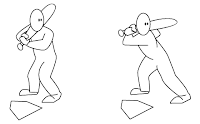1. Stretch & Squash
- When an object moves, its movement indicates the rigidity of the object
- Defining the rigidity and mass of an object by distorting its shape during an action
2. Timing
- defines how well the idea behind the action will read to an audience. It reflects the weight and size of an object
- more drawings between poses slow and smooth the action
3. Anticipation
- Is a preparation for the action, the action proper and the termination of the action.

4. Staging
- Readability – to stage an idea clearly, the audience's eye must be led to exactly where it needs to be at the right moment.
- Personality – to use characteristics that clearly define the character.
- Mood – a mood is staged so that it will affect the audience.
5. Straight Ahead Action and Pose to Pose
- Straight ahead Action
- you can lose size, volume, and proportions
- Motion has spontaneity and freshness
- Pose to pose
- more planned out and charted with key drawings done at intervals throughout the scene.
- Size, volumes, and proportions are controlled.
6. Follow Through and Overlapping Action
- Follow Through
- is the termination of an action
- nothing stops all at once.
- Overlapping Action
- maintains a continual flow between whole phrases of actions
- makes objects seem more natural
7. Slowing in/out or Eases
- Deals with the spacing of the in between drawings between the extreme poses.
- Slow-ins and slow-outs soften the action, making it more life-like.
8.Arcs
- All actions follow an arc or slightly circular path
- Think of natural movements in the terms of a pendulum swinging
- In Computer Animation, motion is usually represented in a time line view using splines(arcs).
- The method used for calculating interpolated key frame values determines the characteristic of the arc(motion).
9. Secondary Action
- Adds to and enriches the main action and adds more dimension to the character animation
- Important in raising the interest and adding a realistic complexity to the animation
10. Exaggeration
- Like a caricature of facial features, expressions, poses, attitudes and actions
- If he is angry, make him furious
11. Solid Drawing
- Transform form, weight, volume solidity into color and movement giving the characters the illusion of three-and four-dimensional life.
- 3D is movement in space.
- 4thD is movement in time.
12. Appeal
- Live actor’s charisma = appeal of animated character
- To create appealing pose avoid "twins”
- Creating a design or an action that the audience enjoys watching












No comments:
Post a Comment